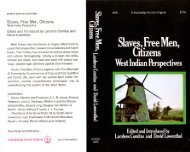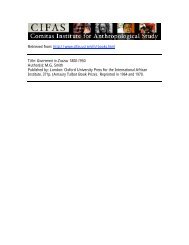You also want an ePaper? Increase the reach of your titles
YUMPU automatically turns print PDFs into web optimized ePapers that Google loves.
THE KANa CHRONICLE AS HISTORY<br />
by<br />
lv1.G. Sl'vlITH<br />
The <strong>Kano</strong> <strong>Chronicle</strong>, published first in an English translation by Sir E.<br />
Richmond PalmerI and nearly twenty-five years later in a l-busa translation<br />
by Dr. Rupert East and his colleagues 2<br />
is unique among indigenous<br />
contemporary documents on Hausa history before the Fu]ani jihad of 1804<br />
1810. There are a number of king-lists for Zaria 3 , Katsina 4 , Kebbi s , and so<br />
forth, but these rarely report events for the reigns they list, and even fewer<br />
report any development during those reigns. Such king-lists are invaluable in<br />
the absence of any other data; but they uften present more puzzles than<br />
answers, more questions than information.<br />
The <strong>Kano</strong> Chronz"cle differs from these royal skeletons in summarizing for<br />
each of the reigns that it reports a varying collection of pertinent incidents<br />
and information. It is preceded by an introductory and speculative sketch of<br />
the culture and composition of the autochthonous population before the<br />
advent of an immigrant group led by a legendary hero, Bagauda, who is<br />
generally believed to have been the grandson of Bayajidda, the mythical<br />
founder of the seven Hausa stat'es, who came from the east to Daura, where<br />
he married the queen, or Magajiya, and shared her rule:t> On this view,<br />
Bagauda came with his host from Daura tu Kana, or rather to Sheme, where<br />
he died, some nine years after the chiefs of Gano, Dab and Debbi. 7 A generation<br />
earlier Barbushe, the priest of Tchunburburai, who lived on Dala, had<br />
foretold the arrival of strangers who would subjugate the lanel and its people,<br />
tne clans that clustered around the rock and worshipped Tsumburburai.<br />
From these beginnings the <strong>Chronicle</strong> traces the emergence and evolution<br />
of the chiefdom of <strong>Kano</strong> until its conquest by the followers or Shehu<br />
Usuman dan Fodio in 1807 after a long contest with the last Hausa chid,<br />
Muhammad Alwali II (1781-1807).<br />
In the absence of any comparable history of a pre-jihadic Hausa state,<br />
the <strong>Kano</strong> <strong>Chronicle</strong> is of special interest, since it records the contexts and<br />
processes by which the polity of <strong>Kano</strong> emerged, and situates its dev





